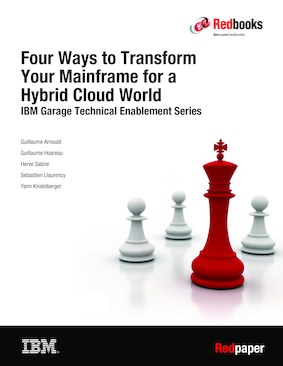About cookies on this site Our websites require some cookies to function properly (required). In addition, other cookies may be used with your consent to analyze site usage, improve the user experience and for advertising. For more information, please review your options. By visiting our website, you agree to our processing of information as described in IBM’sprivacy statement. To provide a smooth navigation, your cookie preferences will be shared across the IBM web domains listed here.

Published on 04 June 2021
Read in Google Books
Share this page:
ISBN-10: 0738459763
ISBN-13: 9780738459769
IBM Form #: REDP-5639-00
Authors: Guillaume Arnould, Guillaume Hoareau, Herve Sabrie, Sebastien Llaurency and Yann Kindelberger
Related video
Hervé Sabrié - Four ways to transform your mainframe for a hybrid cloud world (3:21)
Abstract
The IBM® mainframe remains a widely used enterprise computing workhorse, hosting essential IT for the majority of the world’s top banks, airlines, insurers and more. As the mainframe continues to evolve, the newest IBM Z® servers offer solutions for AI and analytics, blockchain, cloud, DevOps, security and resiliency, with the aim of making the client experience similar to that of using cloud services.
Many organizations today face challenges with their core IT infrastructure:
- Complexity and stability
An environment might have years of history and be seen as too complex to maintain or update. Problems with system stability can impact operations and be considered a high risk for the business.
- Workforce challenges
Many data center teams are anticipating a skills shortage within the next 5 years due to a retiring and declining workforce specialized in the mainframe, not to mention the difficulty of attracting new talent.
- Total cost of ownership
Some infrastructure solutions are seen as too expensive, and it’s not always easy to balance up-front costs with the life expectancy and benefits of a given platform.
- Lack of speed and agility
Older applications can be seen as too slow and monolithic as organizations face an increasing need for faster turnaround and release cycles.
Some software vendors suggest addressing these challenges with the “big bang” approach of moving your entire environment to a public cloud. But public cloud isn’t the best option for every workload, and a hybrid multicloud approach can offer the best of both worlds. IBM Z is constantly being developed to address the real challenges businesses face today, and every day we’re helping clients modernize their IT environments.
There are 4 strategic elements to consider when modernizing your mainframe environment:
- Infrastructure
- Applications
- Data access
- DevOps chain
This paper focuses on these four modernization dimensions.
Table of Contents
Infrastructure modernization
Application modernization
Data access modernization
DevOps chain modernization
Conclusion